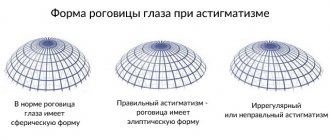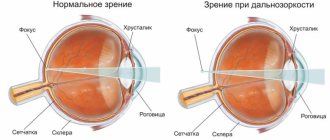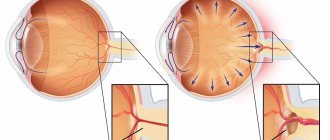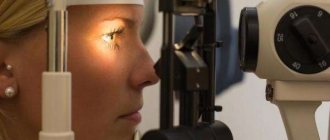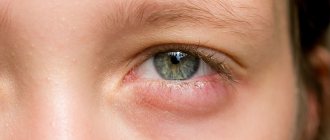Blindness before the eyes is a very common sign of visual impairment, which is characterized by a loss of brightness and clarity of the image visible to the eye. It can vary in how quickly it appears, intensity and duration - the fog can be very dense in the morning and then subside throughout the day. This symptom may not seem particularly serious and may not cause any particular inconvenience, but at the same time it may be a sign of the development of a serious illness.
The veil on the eyes is caused by any changes or deformations of the retina of the eye, which is responsible for projecting the image and converting it into nerve impulses. The consequence of prolonged ignoring of this symptom may be partial or complete loss of visual function.
Symptom Definition
The manifestation of a veil before the eyes.
A veil before the eyes is a visual disturbance in which a person sees as if through a cloudy glass. The symptom may be intermittent and appear only from time to time.
In some cases, the veil before the eyes may be supplemented by such manifestations as:
- Photophobia (increased sensitivity to light);
- Pain in the eyes;
- Appears only at night;
- Spots, floating spots before the eyes;
- Sudden weakness;
- Numbness in one half of the body;
- Increased body temperature.
You should immediately seek medical help if blurred vision is accompanied by the above symptoms.
Causes
The cause of a single case of blurred vision may indicate fatigue and overexertion of a person. A white veil can occur due to “dry eye” syndrome, which, in turn, also occurs from strain on the eyes while working with documents or at the computer. If the cornea dries out, then the endothelium becomes sweaty, which leads to “fog” in the eyes. In this case, the veil does not appear before the eyes all the time, but under certain conditions. Using moisturizing eye drops and gels of a similar nature will quickly drive it out of sight.
If white flashes appear in your eyes, read here.
Another reason for the appearance of veils before the eyes may be the constant use of certain medications. The use of medications such as:
- Antidepressants;
- Oral contraceptives;
- Anticholinergic drugs;
- Corticosteroid drugs;
- Heart medications.
Read more about the signs of astigmatism here.
Why does the view sometimes become blurred over time when worn?
- Lens expiration date. Manufacturers do not just write the expiration date on the packaging. Over time, no matter how much you care for your lenses, processes begin to occur in them that lead to clouding. This can lead to poor vision and eye problems. Try to adhere to wearing periods to avoid inflammation.
- Improper storage. Sometimes people, out of sheer laziness, shorten the “life” of their lenses.
Contact lenses should only be removed and put in after thoroughly washing your hands. After removing, do not forget to clean them by placing them on your palm and applying a few drops of a disinfectant solution. Don’t forget to keep the container in which they are stored clean: the solution should be changed every time after using the lenses, and the container itself every two to three months. - Using a low-quality disinfectant solution. The solution may not be suitable due to individual characteristics or may be expired. After using it, eye irritation and lens clouding may occur. In this case, it is worth purchasing a new solution and putting on a new pair of lenses.
Possible diseases
The frequent appearance of a veil before the eyes indicates the presence of serious pathological processes occurring in the body. In most cases, a veil over the eyes is a harbinger of visual disturbances and disorders. Next, we will consider diseases that can blur vision in the early stages. These include:
- Refractive problems of the eye, for example, myopia, farsightedness, astigmatism. The veil in this case occurs due to incorrect focusing of the image on the retina. Correctly selected glasses or contact lenses will quickly cope with this symptom.
- Presbyopia. Age-related farsightedness can cause blurry vision in people over 40 years of age. The disorder is associated with age-related modification of the optical properties of the lens. First, there is a slight decrease in vision when reading in one eye, then after some time blurred vision occurs in the other eye. The only solution in this case is to select glasses for distance reading. As a result, the veil will disappear.
- Cataract. Clouding of the lens of the eye due to cataracts is the most common cause of blurred vision in older people. The problem is solved by surgery to replace the natural lens with an artificial lens.
- Glaucoma. An increase in intraocular pressure entails a sharp decrease and blurring of vision with the appearance of a white veil in the eyes. This is a very bad sign of glaucoma and requires immediate treatment by an ophthalmologist.
- Age-related macular degeneration of the retina. This is a common cause of central vision loss in people over 60 years of age. At first one eye sees poorly, a veil appears before the eye, then lines and objects become distorted. Treatment of this pathology will help reduce the manifestations of the disease, in addition to this, it will relieve the veil.
- Hemophthalmos. The sudden appearance of a red veil may be a sign of hemophthalmos. Basically, this manifestation occurs in diabetes or in hypertensive patients. Treatment is carried out in a hospital setting and the main task will be the resorption of hemorrhage. Sometimes there is a need for surgical intervention.
- Optic neuritis. This inflammation leads to a deterioration in visual acuity and the appearance of blurred vision. After the course of treatment, vision is completely restored. However, a sudden white veil before the eye may signal a relapse of this disease.
- Migraine. Often people suffering from migraines complain about the appearance of a dark veil in the eye, which is a harbinger of the next attack. Vision is completely restored after the attack ends.
- Transient ischemic attack or stroke. Vascular circulatory disorders in the brain are sometimes accompanied by similar symptoms. In such cases, the patient is treated for the identified disease under the supervision of ophthalmologists.
- Brain tumors. Sometimes a veil on one eye indicates such a very dangerous problem.
Why does a gray veil and black dots appear?
The appearance of so-called “floaters” and a gray veil before the eyes can be a sign that the body has serious pathologies that require mandatory treatment:
- Vegetative-vascular dystonia - in the case of this disease, the above symptoms are considered one of many. The main problem is dysfunction of the autonomic nervous system and the body's response to various factors.
- Migraine. Unbearable pain is accompanied by flashes of light, and in some cases, clear visual dysfunction (black dots appear).
- Osteochondrosis of the cervical spine. This disease impedes the flow of blood to the brain, which is why patients often complain of severe pain, a gray veil appears in the eyes and floating objects in the periphery of vision.
- Hypertension accompanied by visual disturbances.
- Pregnancy. However, this is excusable only in the first half, when there is a sharp restructuring of the body; in the second half, vision problems indicate other diseases.
Diagnostic methods
If a veil appears before your eyes, the first thing you should do is consult an ophthalmologist. The doctor will conduct several types of diagnostics:
- Examination of the eye media using a slit lamp. This manipulation is painless and does not require prior preparation.
- Tonometry of the eye. This is a measurement of intraocular pressure using a weight that is placed on the bottom of the eye after preliminary anesthesia.
- Fundus examination;
- Examination using an ophthalmoscope with preliminary dilation of the pupil;
- Ultrasound of the eyeball.
If such a thorough diagnosis does not reveal any pathology, an examination by a neurologist is necessary, who will prescribe examinations for neurological diseases, for example: determination of reflexes and sensitivity, Dopplerography of the vessels of the head and neck, MRI of the head and neck.
Treatment
Treatment for veils in the eyes directly depends on the cause of this symptom:
- Retinal detachment is treated with eye medications that improve retinal metabolism and vascular patency. In case of severe pathology, laser coagulation (a kind of “gluing”) of the retina to the choroid can be performed.
- If keratitis is detected, drug treatment is prescribed in the form of antimicrobial and anti-inflammatory drops, as well as in the form of tablets and injections that improve the supply of nutrients to the cornea.
Floxal is an antibacterial agent that is used as local therapy during ophthalmic diseases
- If the cornea is damaged, a corneal transplant may be necessary.
- For immature cataracts, the doctor prescribes drops with eye vitamins and nutrients to slow down the clouding of the lens. When the cataract matures, surgery to replace the lens will be required.
- Glaucoma is treated with drops to reduce intraocular pressure. If medication methods do not have an effect, surgical treatment is also performed to relieve acute attacks of glaucoma.
Read about laser iridotomy in the article.
- Dry eye syndrome is treated with moisturizing drops, which are artificial tears (Systane Ultra drops, Hilamax, Hilo-comod).
- A brain tumor is subject to surgery, as well as radiation and chemotherapy.
- In case of a stroke, bed rest is necessary; if it is caused by a blood clot, then in hospitals it is dissolved.
- For anemia, therapy consists of identifying the cause of low hemoglobin and treating it.
- A hypertensive crisis is treated by emergency doctors, and treatment takes place in the cardiology or therapy department.
- Diabetic retinopathy is treated in tandem by an ophthalmologist and an endocrinologist, who selects insulin doses for the patient. The ophthalmologist, in turn, prescribes medications that allow the vessels to more effectively nourish the structures of the eye.
Read more about Systane Ultra drops in the material.
Treatment of the identified disease, giving up bad habits, playing sports (within reason) and proper nutrition can prolong eye health for many years. The effectiveness of treatment directly depends on the correct diagnosis.
Blindness before the eyes is a symptom that often gives an unfavorable prognosis, so it is very important to stop the disease at an early stage, while vision can still be preserved.
Preparations from the “Artificial tear” series
Our services in ophthalmology
The administration of CELT JSC regularly updates the price list posted on the clinic’s website. However, in order to avoid possible misunderstandings, we ask you to clarify the cost of services by phone: +7 (495) 788 33 88
| Service name | Price in rubles |
| Ultrasound scanning of the anterior segment of the eye | 1 000 |
| Comprehensive OCT examination of the retina (one eye) | 3 500 |
| Antiglaucomatous surgery for primary glaucoma stage 1 of the disease | 55 000 – 85 000 |
| Vitrectomy with cataract phacoemulsification without IOL cost | 90 000 – 130 000 |
Prevention
Preventive measures in such a case are aimed at protecting one’s own body from diseases that cause the appearance of fog or a veil before the eyes. In order to prevent the above diseases, doctors advise:
- Regularly measure your blood pressure and prevent a hypertensive crisis by regularly taking blood pressure-lowering medications prescribed by your doctor.
- Control sugar levels to prevent destruction of retinal vessels.
- Follow hygiene rules to avoid infection in the organs of vision.
- In case of severe head injuries or bruises, consult a doctor immediately.
- Be examined annually by an ophthalmologist, especially for people over 40 years of age. It is from this period that people’s risk of developing cataracts and glaucoma increases significantly.
Shroud color: dark
This phenomenon does not occur as often as the veil of other shades, but it also indicates obvious problems existing in the body:
- Migraine. It usually manifests itself in people who are genetically predisposed to it, under the influence of certain factors - stress, moral and physical exhaustion, strong emotional experiences, changes in climatic conditions. Migraine manifests itself as excruciating throbbing pain in the head, often one-sided. May be accompanied by various symptoms: dizziness, visual hallucinations, blurred vision, nausea. The pain intensifies from surrounding sounds and smells, as well as from sudden movements. These same symptoms are characteristic of a developing stroke, so if they appear, you should consult a doctor.
- Retinal disinsertion. In this case, the essence of the disease is the detachment of the retina, which contains photoreceptors. There can be many reasons:
- mechanical eye injury;
- high myopia (decreased vision) or farsightedness;
- strong physical activity (including childbirth);
- hypertension.
The development of the pathological process occurs gradually. The first symptoms are unpleasant sensations in the eyes at the visual level, usually these are “spots” or flashes of light. Over the course of some time, the patient begins to notice a veil, which gradually takes up more and more space, interfering with the normal perception of surrounding objects. Visual acuity decreases, sometimes double vision and strabismus occur.
Failure to see a doctor in a timely manner can cause complete detachment of the retina from the eye and permanent loss of vision.
In this case, coagulation of the retina is considered a preventive measure - during this procedure, weak points of attachment of the retina are “sutured” with a laser. With normal development of coagulates in the eye, retinal detachment can be prevented. Typically, this procedure is recommended for people at risk, for example, patients with a weakened retina due to high myopia.
conclusions
We often take excellent vision for granted. However, you should always remember that many visual pathologies begin their development almost asymptomatically. Sometimes alarm bells (such as a veil before our eyes) are still noticed by us, but, unfortunately, we ignore them in the hope of self-healing. Each of us should know that fog and blurred vision are a very serious reason to contact an ophthalmologist to prevent vision loss.
To find out what causes of visual impairment exist, follow the link.

